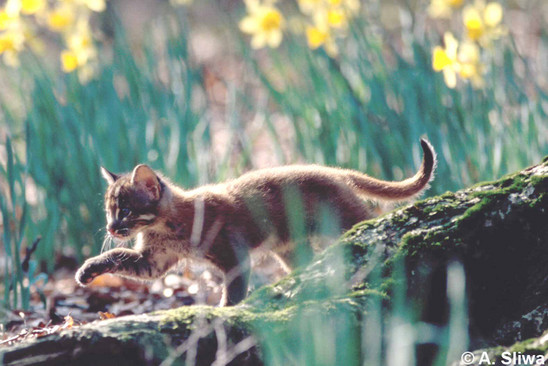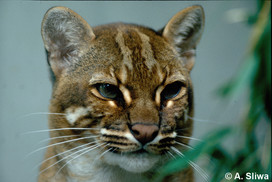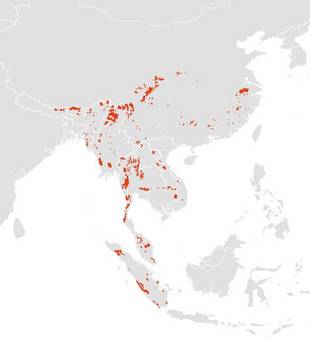Asiatic golden cat
Catopuma temminckii
IUCN Red List: Near Threatened
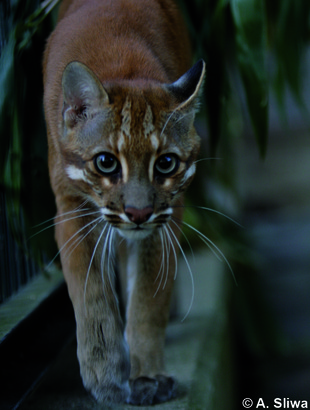
| Weight: | 9-16 kg |
| Body length: | 71-105 cm |
| Tail length: | 40-56 cm |
| Longevity: | up to 17 years |
| Litter size: | 1-3 cubs |
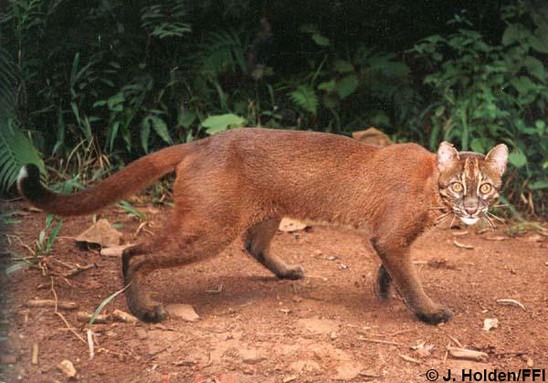
Description
The Asiatic golden cat (Catopuma temminckii) is a medium sized cat with relatively long legs. It is similar in appearance to the African golden cat (Caracal aurata), however, recent genetic analyses indicate it is more closely related to the Borneo bay cat (Catopuma badia) cat and the marbled cat (Pardofelis marmorata). Two subspecies of the Asiatic golden cat are suggested:
- Catopuma temminckii temminckii on Sumatra and the Malay Peninsula
- Catopuma temminckii moormensis from Nepal to North Myanmar, China, Tibet and South-East Asia.
The Asiatic golden cat is remarkably polymorphic in its pelage. The most common coat colour is golden or red brown, but it may also be dark brown or even grey. Melanistic individuals have been reported and may be predominant in some areas of its range. There is also a spotted form which is called an “ocelot morph” due to its ocelot-like rosettes. To date, this form has been reported from China (in Sichuan and Tibet) and from Bhutan. If biogeographic patterns exist in regard to the different coat colour types is not known yet and needs further investigation. The most distinct features of this cat are the white lines bordered with dark brown to black running across the cheeks, from the nostrils towards the cheeks, at the inner corner of the eyes, and up the crown. The rounded ears have black backs with a grey spot. The chest, abdomen and inner side of the upper legs are white with light speckling. The legs and tail are grey to black at the distal ends. The terminal half of the tail is white on the underside and is often carried with the end curled dorsally. Males are larger than females.
Language/Country | Name |
|---|---|
Bangladesh (Bengali) | shonali biral |
Chinese | jin mao, huang hu, zhi ma bao |
English | Temminck's cat, Golden cat |
French | chat doré d'Asie, Chat de Temminck |
German | Asiatische Goldkatze |
India (Bengali) | shonali biral |
Indonesia | kucing emas |
Laos | sua meo, sua pa |
Malaysia | kucing tulap, harimau anjing |
Myanmar | kya min, kyaung min |
Shan | hso hpai, miao thon |
Spanish | gato dorado asiático |
Thailand | sua fai (fire tiger) |
Status and Distribution
The Asiatic golden cat is listed as Near Threatened in the IUCN Red List, but there is little specific information about the species available and its population status is largely unknown. In Nepal, the Asiatic golden cat is listed as Data Deficient, in Bangladesh as Vulnerable and in China as Critically Endangered. In some areas of its range it appears to be relatively uncommon. It was infrequently reported in south China, and thought to be rarer than the clouded leopard and leopard cat in that region. The Asiatic golden cat is infrequently detected in eastern Cambodia, Laos and Vietnam. The last record from Vietnam dates back to 2005 and in the Chinese Provinces Yunnan, Sichuan, Guangxi and Jiangxi during an extensive survey, the species was only detected three times. However, in other areas it appears to be one of the more common small felid species. Studies in Laos, Thailand, and Sumatra have recorded the Asiatic golden cat more frequently than sympatric felid species such as the marbled cat, Mainland clouded leopard and Sunda clouded leopard. The distribution of the species is limited and patchy in Bangladesh, India and Nepal. In Bhutan, Indonesia, Malaysia, Myanmar and Thailand it is more widely distributed. Overall, the number of Asiatic golden cats is thought to be decreasing throughout their range due to extensive habitat loss and continued illegal poaching.
The distribution of the Asiatic golden cat is similar to that of the Mainland clouded leopard (Neofelis nebulosa), the Sunda clouded leopard (Neofelis diardi) and the marbled cat. It occurs from the foothills of the Himalaya into China and Southeast Asia. It also inhabits Bangladesh, Bhutan, Cambodia, India, Indonesia, Lao PDR, Malaysia, Myanmar, Nepal, Thailand and Vietnam. It does not occur on Borneo. In India it has only been recorded in the north-eastern states Assam, Arunachal Pradesh and Sikkim.
Habitat
The Asiatic golden cat has a similar distribution to the clouded leopard and the marbled cat. It occurs in different forested habitats such as tropical and subtropical moist evergreen forests, mixed evergreen forests, and dry deciduous forests. Occasionally it has been reported from more open habitats such as shrub and grasslands, or open rocky areas. Two radio collared individuals (a male and a female) in Thailand occurred most often in closed forest habitats. A radio collared female on Sumatra was frequently recorded outside of a protected area in remnant fragments of forest located between coffee plantations. The species has also been recorded by camera traps located in, or near, oil palm and coffee plantations on Sumatra. In Bhutan, the species was recorded in tropical and sub-tropical moist evergreen and dry deciduous forest and open habitats. It was also found in areas of dwarf rhododendron forest and grasslands at high elevations, conifer, cool broadleaf and mixed-conifer forests and in areas dominated by warm broad-leaved forests. Highland areas in Butan seem to contain important habitat for the species and possibly act as corridors. Thus, these areas may play an important role for the conservation of the Asiatic golden cat, even more as lowlands are more prone to habitat conversion.
The Asiatic golden cat is frequently recorded at relatively high altitudes. It has been documented at elevations up to 3,050 m in Sikkim, India, and in the Jigme Sigye Wangchuk National Park in Bhutan it was recorded at an elevation of 3,738 m in an area of dwarf rhododendron and grassland. The elevation record is 3,960 m where an Asiatic golden cat was pictured in the Khangchendzonga Biosphere Reserve Sikkim, India. In Bhutan, it was even pictured at 4,033 m in Jigme Dorji National Park and at 4,282 m in the montane forests of Wangchuck Centennial National Park, Bhutan. However, in some areas it appears to be more common in lowland forests. In Kerinci Seblat National Park on Sumatra, it was only recorded by camera traps at low elevations and in teh Royal Manas National Park, Bhutan at 80 m. In the hill forests of India’s western Arunachal Pradesh province, the Asiatic golden cat was not recorded by camera traps, despite the occurrence of both marbled cats and clouded leopards.
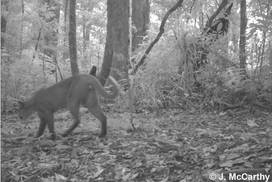
- Camera trap picture of a male Asiatic golden cat, Sumatra.
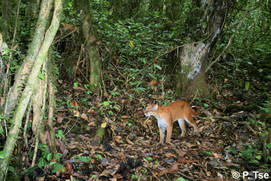
- Asiatic golden cat on Sumatra.
Ecology and Behaviour
Little is known about the ecology and behaviour of the Asiatic golden cat. It was once thought to be primarily nocturnal; however, recent data indicates that it may be more crepuscular to diurnal. In Jigme Dorji National Park, Bhutan, for example, the Asiatic golden cat was active during day and night. Two radio-collared golden cats in Thailand’s Phu Khieu National Park showed mainly diurnal and crepuscular activity peaks. In addition, most camera trap photographs of Asiatic golden cats in the Kerinci Seblat and Bukit Barisan Selatan National Parks on Sumatra were taken during the day.
The home ranges of two radio collared golden cats in Thailand's Phu Khieu National Park were 33 km² (female) and 48 km² (male), and overlapped significantly. On Sumatra, a radio collared female spent a significant portion of time outside of the protected area in small patches of remnant forest located among coffee plantations.
In captivity a variety of different vocalisations and scent marking behaviours have been observed. The Asiatic golden cat gives birth in hollows on the ground, under rocks and/or trees. Estrus lasts for approximately 6 days, the estrus cycle for 39 days and gestation on average for 80 days. The average litter size is one to two kittens. Sexual maturity is reached at 18-24 months for females and 2 years for males. Asiatic golden cats show sexual dimorphism in body size with males (12-16 kg) weighting generally 50-75% more than femals (8-10 kg).
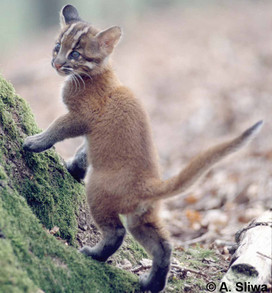
- Young Asiatic golden cat.
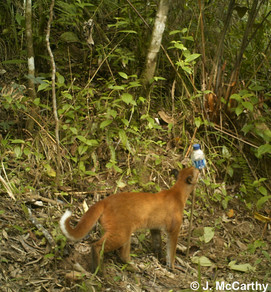
- Asiatic golden cat inspecting a lure station.
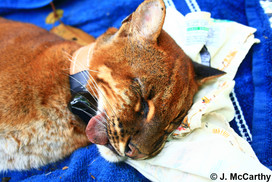
- Anesthetized Asiatic golden cat.
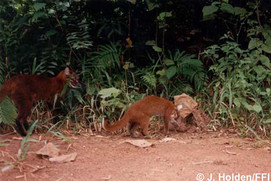
- Asiatic golden cats.
Prey
The Asiatic golden cat is primarily a terrestrial hunter, although locals claim it is also an adept climber. It was thought that the Asiatic golden cat preys mainly on large rodents. Nowadays it is known to prey on differen species and seems to be a generalist and opportunistic forager with a high niche breadth. It is known to prey on amphibians, small reptiles (lizards, snakes), insects, birds, primates, poultry and small ungulates such as muntjac and chevrotains. Asiatic golden cats have been reported to prey on larger animals such as gorals in the mountains of Sikkim, India; wild pigs and sambar deer in north Vietnam; and young calves of domestic water buffalo. Scat analysis in Taman Negara National Park, Peninsular Malaysia, revealed that Asiatic golden cats also prey on species such as the dusky leaf monkey and mouse deer. On Sumatra there have been reports from local people that Asiatic golden cats occasionally prey on poultry and in Bangladesh to take domestic goats. In a scat analysis study from Laohegou Nature Reserve, China, Temminck's tragopan (Tragopan temminckii), the Chinese bamboo rat (Rhizomys sinensis) and pkas (Ochotona spp.) were its most common prey species. Beside, rats, voles, squirrels and birds, also remains of wild boar (Sus scrofa), takin (Budorcas taxicolor), forest musk deer (Moschus berezovskii) and primates (golden snub-nosed monkey (Rhinopithecus roxellana) and Rhesus macaque (Macaca mulatta) were found. In Laos, Asiatic golden cat preyed on 13 species. Its main prey was muntjac followed by murid rodents and carnivores. It also took 13 different birds, rodents and shrews, wild pig, mainland serow, domestic goat, palm civet and hog badger. In Myanmar the Asiatic golden cat preyed mainly on mammals (rodents) followed by snakes and lizards.
Main Threats
There is a general lack of information on Asiatic golden cat populations and their status, as well as a low level of public awareness. However, the main threats to the Asiatic golden cat appear to be habitat loss and alteration due to deforestation across its range. Southeast Asian forests are undergoing the world’s fastest regional deforestation rates due to the expansion of oil palm, coffee, acacia, and rubber plantations. The Asiatic golden cat is also threatened by hunting for its pelt and bones which are used in traditional medicine, and also for its meat which is considered a delicacy in some areas. In some regions people believe that the consumption of Asiatic golden cat meat increases strength and vigour. It is for example hunted for meat in the Chittagong Hill Tracts in Bangladesh. In Myanmar too, its meat is sometimes consumed. Poaching of the species is thought to be increasing in many areas. Trade in Asiatic golden cat furs was observed along the Myanmar-Thailand and Myanmar-China border and in Sumatra as well as from areas in northeast India. In south China, it has come increasingly under demand for this purpose as significant declines in tiger and leopard populations have shifted the focus to smaller felid species. Local people follow the tracks of the Asiatic golden cats and set snares or use hunting dogs to locate and corner the Asiatic golden cat. The species is also threatened by indiscriminate snaring and by declining prey abundance due to a high hunting pressure. Indiscriminate cables-snare trapping in Vietnam has probably already extirpated the Asiatic golden cat from many protected areas.
The Asiatic golden cat is also killed in retribution for livestock depredation. A study in villages around Bukit Barisan Selatan National Park in Sumatra indicated that Asiatic golden cat occasionally preyed on poultry and were often persecuted as a result. The Asiatic golden cat is reported to also take larger animals such as sheep, goats, buffalo calves and other ungulates, leading to conflicts. In some areas, ddisease transmission is considered anther threat to the species.
Conservation Efforts and Protection Status
The Asiatic golden cat is listed in Appendix I of CITES and fully protected over most of its range. Hunting is officially prohibited in Bangladesh, Cambodia, China, India, Indonesia, Peninsular Malaysia, Myanmar, Nepal, Thailand and Vietnam and is regulated in Lao PDR. There is no legal protection outside protected areas in Bhutan. The Asiatic golden cat is listed as Scheduled I species in teh Indian Wildlife (Protection) Act 1972. Generally, greater regulation and enforcement of national and international laws are required to conserve the species on the long-term. Conservation of habitat and the establishment of habitat corridors are also important for the protection of the Asiatic golden cat.
More studies on the ecology, biology and status of the Asiatic golden cat are urgently needed. There is also a need to involve local people in the conservation of the species, its prey and its critical habitat.
